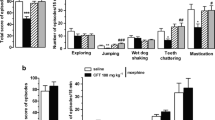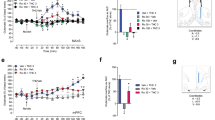Abstract
The non-selective excitatory amino acid antagonist kynurenic acid, which does not readily cross the blood-brain barrier, dose-dependently attenuated the behavioral signs of naltrexone-precipitated withdrawal in morphine-dependent rats following both intraventricular and subcutaneous administration. However, intraventricular and subcutaneous administration of kynurenic acid and different effects on individual withdrawal behaviors. Moreover, single unit recordings in anesthetized animals showed that intraventricular, but not subcutaneous, kynurenic acid administration attenuated the withdrawal-induced increased firing of locus coeruleus neurons. These studies indicate that: (1) both central and peripheral excitatory amino acid receptors may play an important role in opiate withdrawal; and (2) excitatory amino acid antagonist treatments might be developed to reduce opiate abstinence symptoms in man.
Similar content being viewed by others
References
Aceto MD, Dewey WL, Portoghese PS, Takemori AE (1986) Effects of b-flunaltrexamine (b-FNA) on morphine dependence in rats and monkeys. Eur J Pharmacol 123:387–393
Aghajanian GK (1978) Tolerance of locus coeruleus neurones to morphine and suppression of withdrawal response by clonidine. Nature 276:186–187
Bianchetti A, Giudice A, Nava F, Manara L (1986) Dissociation of morphine withdrawal diarrhea and jumping in mice by the peripherally selective opioid antagonist SR 58002 C. Life Sci 39:2297–2303
Blasig J, Herz A, Reinhold K, Zieglgansberger S (1973) Development of physical dependence on morphine in respect to time and dosage and quantification of the precipitated withdrawal syndrome in rats. Psychopharmacologia 33:19–38
Germano IM, Pitts LH, Meldrum BS, Bartkowski HM, Simon RP (1987) Kynurenate inhibition of cell excitation decreases stroke size and deficits. Ann Neurol 22:730–734
Gill R, Woodruff GN (1990) The neuroprotective actions of kynurenic acid and MK-801 in gerbils are synergistic and not related to hypothermia. Eur J Pharmacol 176:143–149
Gold MS, Redmond DE Jr, Kleber HD (1978) Clonidine blocks acute opiate-withdrawal symptoms. Lancet ii:599–602
Himmelsbach CK, Gerlach GH, Stanton EJ (1935) A method for testing addiction, tolerance, and abstinence in the rat. J Pharmacol Exp Ther 53:179–188
Jasinski DR, Johnson RE, Kocher TR (1985) Clonidine in morphine withdrawal: differential effects on signs and symptoms. Arch Gen Psychiatry 42:1063–1066
Kolb L, Mimmeisbach CK (1938) Clinical studies of drug addiction, III. A critical review of the withdrawal treatments with method of evaluating abstinence syndromes. Am J Psychiatry 94:759–799
Perkins MN, Stone TW (1982) An iontophoretic investigation of the actions of convulsant kynurenines and their interactions with the endogenous excitant quinolinic acid. Brain Res 247:184–187
Rasmussen K, Aghajanian GK (1989) Withdrawal-induced activation of locus coeruleus neurons in opiate-dependent rats: attenuation by lesions of the nucleus paragigantocellularis. Brain Res 505:346–350
Rasmussen K, Beitner-Johnson DB, Krystal JH, Aghajanian GK, Nestler EJ (1990) Opiate withdrawal and the rat locus coeruleus: behavioral, electrophysiological and biochemical correleates. J Neurosci 10:2308–2317
Rasmussen K, Fuller RW, Stockton ME, Perry KW, Swinford RM, Ornstein PL (1991) NMDA receptor antagonists suppress behaviors but not norepinephrine turnover or locus coeruleus unit activity induced by opiate withdrawal. Eur J Pharmacol 197:9–16
Redmond DE Jr, Krystal JH (1984) Multiple mechanisms of withdrawal from opioid drugs. Ann Rev Neurosci 7:443–478
Shannon HE, Sawyer BD (1989) Glutamate receptors of the N-methyl-d-aspartate subtype in the myenteric plexus of the guinea pig ileum. J Pharmacol Exp Ther 251:518–523
Stone TW, Connick JH, Burton NR, Smith DAS (1987) Quinolinic acid and kynurenic acid as endogenous ligands at NMDA receptors. In: Hicks, TP, Lodge, D, McLennan, H (eds) Excitatory amino acid transmission. Liss, New York, pp 147–152
Swartz KJ, During MJ, Freese A, Beal MF (1990) Cerebral synthesis and release of kynurenic acid: an endogenous antagonist of excitatory amino acid receptors. J Neurosci 10:2965–2973
Taylor JR, Elsworth JD, Garcia EJ, Grant SJ, Roth RH, Redmond DE Jr (1988) Clonidine infusion into the locus coeruleus attenuates behavioral and neurochemical changes associated with naloxone-precipitated withdrawal. Psychopharmacology 96:121–134
Thollander M, Hellstrom PM, Svensson TH (1989) Suppression of small intestinal motility and morphine withdrawal diarrhoea by clonidine: peripheral site of action. Acta Physiol Scand 137:385–392
Tseng L-F, Loh HH, Wei ET (1975) Effects of clonidine on morphine withdrawal signs in the rat. Eur J Pharmacol 30:93–99
Tung C-S, Grenhoff J, Svensson TH (1990) Morphine withdrawal responses of rat locus coeruleus neurons are blocked by an excitatory amino-acid antagonist. Acta Physiol Scand 138:581–582
Turski L, Schwarz M, Turski W, Klockgether T, Sontag K, Collins JF (1985) Muscle relaxant action of excitatory amino acid antagonists. Neurosci Lett 53:321–326
Valentino RJ, Wehby RG (1989) Locus coeruleus discharge characteristics of morphine-dependent rats: effects of naltrexone. Brain Res 488:126–134
Way EL, Loh HH, Shen F-H (1969) Simultaneous quantitative assessment of morphine tolerance and physical dependence. J Pharmacol Exp Ther 167:1–8
Wei E (1973) Assessment of precipitated abstinence in morphine-dependent rats. Psychopharmacologia 28:35–44
Author information
Authors and Affiliations
Rights and permissions
About this article
Cite this article
Rasmussen, K., Krystal, J.H. & Aghajanian, G.K. Excitatory amino acids and morphine withdrawal: differential effects of central and peripheral kynurenic acid administration. Psychopharmacology 105, 508–512 (1991). https://doi.org/10.1007/BF02244371
Received:
Revised:
Issue Date:
DOI: https://doi.org/10.1007/BF02244371




